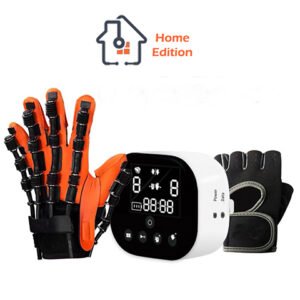Robotic Rehabilitation Gloves assistance in Spasticity Treatment
Spasticity is a muscular stiffening or tightening disorder that prevents normal fluid movement. Muscles remain tight and resist stretching, causing problems with movement, speech, and gait.
Damage or disruption to the part of the brain and spinal cord that controls muscle and stretch reflexes is the most common cause of spasticity. An imbalance in the inhibitory and excitatory impulses supplied to the muscles might cause them to lock in place, creating these disturbances.
Spasticity, which affects muscles and joints, can be hazardous to growing children. Spasticity can be present in those who have had a brain injury, spinal cord injury, cerebral palsy, or multiple sclerosis.
Indeed, Spasticity is one of the most prevalent stroke consequences. It usually appears months or even a year following a stroke. Spasticity is a difficult and uncomfortable issue for stroke survivors, but there are remedies and strategies to manage it.
Fortunately, there are various therapeutic choices for spasticity, and most patients receive multiple treatments at the same time. Spasticity treatment requires a combination of exercise during physical therapy in order to successfully relieve symptoms and enhance the quality of life.
Because spasticity has a considerable influence on everyday activities, treating this disability is an important component of neurological rehabilitation. Hereby, a supporting medical device, such as the Portable Rehabilitation Robotic Gloves: SIFREHAB-1.0 which is highly recommended by our technical medical team to achieve a quick recovery process.
SIFREHAB-1.0 delivers real-world, task-specific applications that aid patients in their rehabilitation and prepare them for the transition back to regular life.
Since physical and occupational therapies effectively alleviate symptoms and improve the quality of daily life of patients with spasticity, Rehabilitation Robotic Gloves SIFREHAB-1.0 would help in the stretching and strengthening exercises to enhance strength and coordination, resulting in better performance of daily activities.
With Activities of daily living (ADL) training mode that will focus on improving mobility through targeted exercises and Mirror therapy training mode; where mirror neurons are activated when both hands move at the same time to recreate normal hand nerve connections to the damaged hand, patients will be assisted in regaining their hand functions through exercise, as well as their capacity to care for themselves in everyday life.
To sum up, In individuals with Spasticity, an intense activity-based rehabilitation program is adequate to enhance long-term neuromuscular activity. The neuromuscular mechanism of action and the minimum rehabilitation program required with the Rehabilitation Robotic Gloves assistive device SIFREHAB-1.0 to help with ADL activities and importantly assist in Spasticity Treatment.
References: Overcoming Muscle Spasticity, Current Practices of Physical and Occupational Therapists Regarding Spasticity Assessment and Treatment, Neurosurgical Conditions andTreatments: Spasticity,

